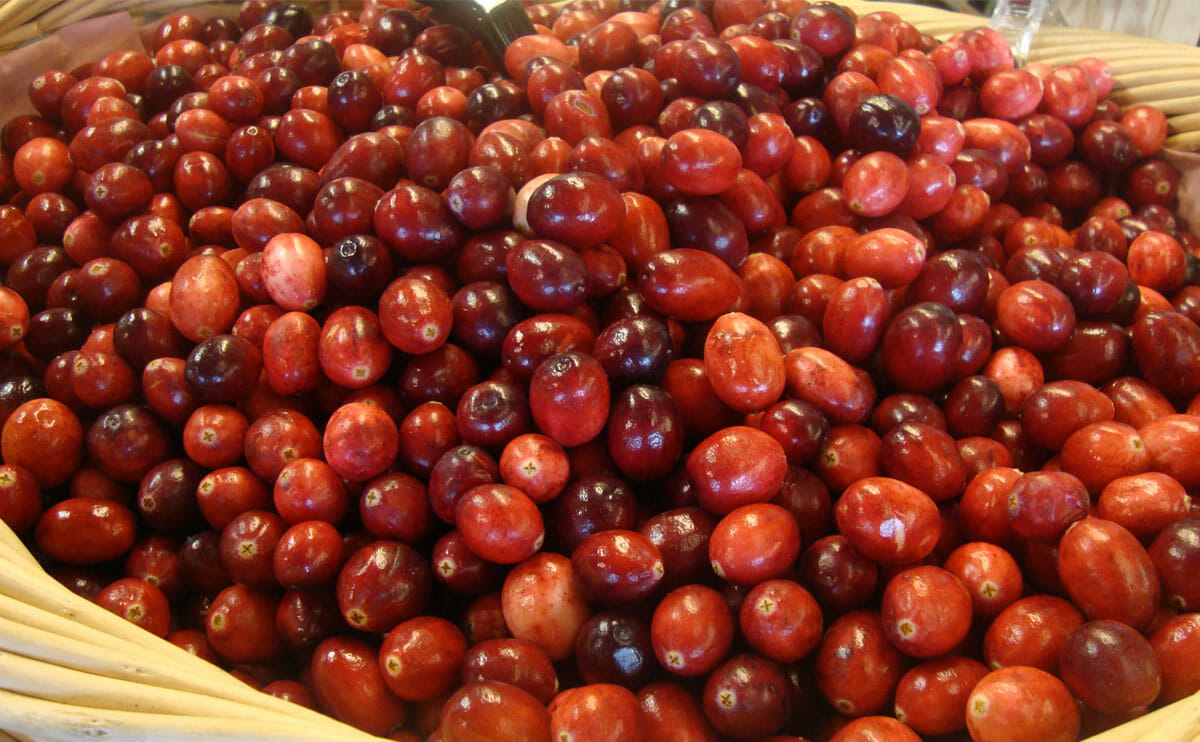Each week we highlight what is seasonal, talk to those who grow it and share a recipe (or two).This week: cranberries.

The Vermont Cranberry Company, located in East Fairfield, is the first commercial grower of cranberries in Vermont. Bob Lesnikoski, a former logging contractor and self-taught farmer, began growing cranberries in 1996. Today, his company continues to grow — with help from his wife, Elizabeth, and their three children, all of whom assist with growing, harvesting and meticulously hand-sorting berries. On a little less than three acres, The Vermont Cranberry Company produces just over 20,000 pounds of cranberries annually from its three man-made bogs.
Modern Farmer caught up with Bob, also known as “Cranberry Bob,” to chat about his berry operation.
Modern Farmer: How did you get into the cranberry business?
Bob Lesnikoski: For quite awhile, I was a logging contractor who was looking for another profession. At that time, the cranberry industry was expanding from Massachusetts to Maine. During my job transition, I decided to meet some of the growers in Maine to see if the berries would be a good fit for my property. After my conversation with the growers, I decided that growing cranberries was a good idea and opted to give the fruit a try.
MF: Why is growing cranberries rewarding?
BL: The berries are nostalgic and festive fruit. They are a part of the holiday fabric, particularly in New England. The whole family packs the fruit almost everyday. Then I deliver them throughout Vermont. We are pretty tired by the time the holiday season rolls around. It is rewarding to sit down at the table during our Thanksgiving meal and think about all the people throughout Vermont who are enjoying our cranberries.
MF: Tell me about your growing practices.
BL: Our pest complex is very mild. We are very low input, meaning we do not use a lot of chemicals. Fruit rot can be a challenge and we do use a fruit rot spray but, other than that, most years there is not much chemical input. We live on the farm and our water source is next to one of our cranberry beds, so we are very aware, and careful, about how we grow and manage the berries. We are a small grower, so we can grow fruit using the cultural practices that were developed before chemical inputs became common ”“ for example, hand weeding. During the company’s first three years, when I was developing the beds, there was a tremendous amount of hand weeding. The whole family rallied together to help make the beds weed-free. Now that they have been established, they don’t need as much weeding. I do live with a certain amount of weeds as long as they don’t compromise the quality, or health of the fruit.
MF: What do you find to be the biggest challenges when growing cranberries?
BL: You are at the mercy of the weather. We have had hail damage. Hail is a tough one because there is just absolutely nothing you can do. Every year the late spring and early fall frosts are an issue; with a cranberry farm you have to have an irrigation system in place. Once the temperature gets below tolerance, which is 32 degrees, I turn on my irrigation system to protect the plants. Frost events are somewhat controllable by running the irrigation system. However, that entails me being up all night managing my water pumps and sprinkler heads until the frost events are over.
MF: When is cranberry season in Vermont?
BL: The bulk of our harvest is the first week of October.
MF: Given the hard labor of farming, what keeps you going?
BL: One of the reasons why I changed from the forest product industry to farming (particularly with a perennial fruit) was because it enabled me to be personally invested in my property, cranberry beds, and fields. If done right, my plants are going to outlive me and hopefully, a family member, or another young farmer, will continue my efforts. These cranberries can be my legacy, which is very important to me.
[mf_editorial_break layout=”twocol” title=”Winter Pudding with Caramelized Cranberries”]
Adapted from The Bakery at the Farmhouse Kitchen
Note that this recipe makes more cranberry sauce than you will need in the cake; save the extra cranberries and serve over ice cream or pancakes. Be sure not to overmix the batter in step 3 or the pudding will not rise as much. In the summer, this recipe works well with sour cherries.
Serves 8
2 cups granulated sugar
2 tablespoons water
3 cups fresh cranberries
8 tablespoons (4 ounces) unsalted butter
3/4 cup all-purpose flour
2 teaspoons baking powder
Pinch of salt
3/4 cup milk
1/2 teaspoon vanilla extract
Preheat oven to 350 degrees.
Combine 1 cup of the sugar and the water in a medium skillet over medium-low heat and stir until the sugar begins to dissolve. Add the cranberries and continue to cook, stirring often, until they soften and begin to pop, about 10 minutes. Set aside.
Melt the butter in a 10-inch cast-iron skillet in the oven. Sift the remaining 1 cup sugar, the flour, baking powder, and salt into a medium bowl. Add the milk and vanilla, stirring until almost combined. Do not overmix.
When the butter has melted, carefully remove the pan from the oven. Pour the batter into the middle of the pan. As you pour, quickly tilt the pan in all directions to spread the batter evenly across the bottom of the pan.
Pour 2 cups of the cranberries in the middle of the dough. Do not mix the berries into the batter. Carefully return the pan to the oven and bake until the fruit starts to bubble and the edges are nicely browned, 45 minutes to 1 hour. Let cool slightly, then serve.
Reprinted with permission from The Vermont Farm Table Cookbook by Tracey Medeiros, copyright © 2013. Published by Countryman Press.
[/mf_editorial_break]